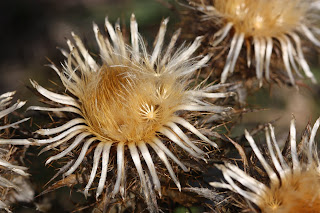Before we had even left Killingworth we had a close up sighting of a Common Buzzard flying over the estates, and as we drove along the Beehive road we passed a Short Eared Owl in flight over the fields, being mobbed by corvids. So, a nice start to our trip out.
I have
eventually got round to reading Benedict MacDonald’s Rebirding and his co-authored
follow up Orchard. The latter
included a description of the garden/orchard in Hungary at the property at
which we had stayed six years ago (blimey how time passes), thus giving this a
very personal feel. Both excellent reads
but at times depressing when considering the wildlife lost from Great Britain,
not only in recent decades, but over the centuries. I am not sure I view all the suggestions for rewilding
as achievable, certainly not without a major change in attitudes to the great
majority of our inhabitants. Nevertheless, I am all for positivity,
and in thinking big maybe positive changes can be made on a large scale. One point I certainly concur with, whilst I
understand the restraints upon organisations involved with conservation, I also
note a rather weak approach from them at times, so a kick up the backside may
be what is required to ensure they act with the interests of wildlife at heart,
over and above the attempts to please everyone.
Thankfully,
we still have good chances to watch wildlife in our region and I gave a short
account of two recent experiences. Both
instances simply recall experiences easily achievable on our doorstep. Building back better, whatever that means,
ought to include a relook at how our country is managed for nature.
Brier Dene
proved to be generally quiet during our walk although the call of Yellow
Browed Warbler was among what we did encounter. I am all for stopping in one spot and letting
birds come to me and we experienced that today.
In a rather decayed area of the dene we got our eye on a Willow Tit
that showed several times. Waiting
around a while it wasn’t long before we were also watching several other
species in this one tiny patch of the dene as a Chiffchaff was heard in
the same trees. A male Bullfinch
in pristine condition and glowing colour appeared, as did an equally colourful Grey
Wagtail. A male Blackcap
arose from the burn and showed well along with Song Thrush, Blackbird, Chaffinch
and tits. Behind us a Peacock
Butterfly showed off its stunning colours as it bathed in sunlight, perhaps
before finding a suitable spot for hibernation.
Later, as we
approached St Mary’s Island we watched a flock of Golden Plover in
flight. Walking further and passing the
ploughed farmland a patch of xanthous colouring stood out in the now murky
light. A closer look confirmed that this was indeed
the flock of Golden Plover which could so easily have been overlooked,
and no doubt was by many passers-by.
Each bird a wonderful golden colour, the dullness of the light enhancing
the plumage colouring and making the large dark eyes of each individual bird
show prominently in a wonderful atmosphere.
The mass calling of the flock was barely audible and in the growing
gloom seemed almost melancholic. There
was much movement of individual birds within the flock which seemed unsettled
and ready to lift at any point. On
scanning the area closely more and more shapes of Curlew were also
picked up, although well camouflaged in the dimness and against the dark of the
mud coloured earth. Lapwings were
the first birds to lift in that slow lapping flight that is so
recognisable. They were followed into the
air by a few, then the whole flock of Golden Plovers and with them a
small number of the Curlews. There were soon myriad birds in the air and
way above them another flock of Golden Plover. Adding to the mass was a mini murmuration of Starlings
appearing like a drifting magic carpet of dark smoke curved shape. A few Linnets by the side of the road
also lifted as if in synchronisation with the flocks behind them and a Grey
Heron entered the stage. Just as
quickly as lifting, the birds once again dropped to the ground. Natures magic moments such as this ought not
to be missed and once again we were rewarded for simply standing still and
watching.
With mimic darkness, in their numerous flight.
John Clare/October, The Shepherds Calendar














































